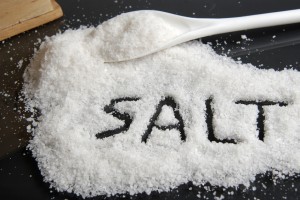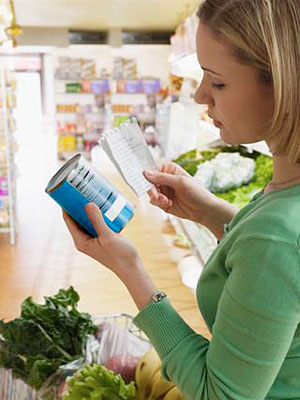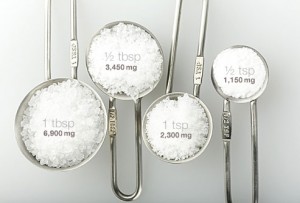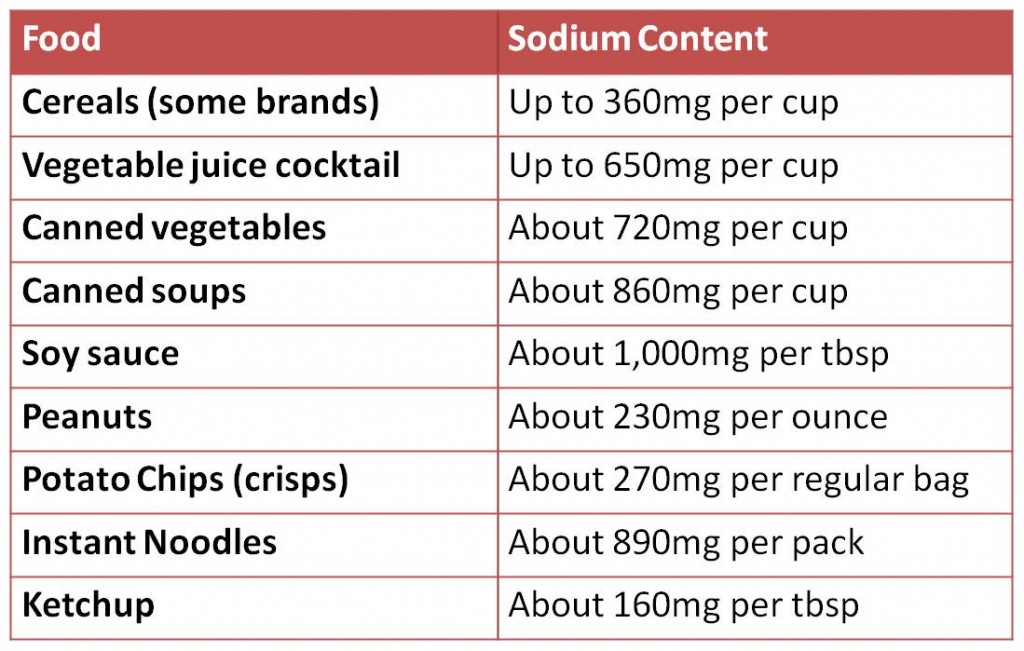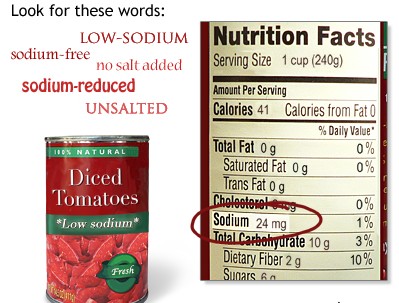How Much Sodium Is Too Much?
The recommendation for a healthy person is to keep sodium intake below 2400 milligrams (2.4 grams) per day. People with high blood pressure may need to stay below 1500 milligrams (1.5 grams). One teaspoon of salt has about 2300 milligrams sodium. Just one-quarter teaspoon has 580 milligrams and a dash of salt has around 150 milligrams.
You’ll find sodium in most butter or margarine, milk, bread and other staple foods. Heavily processed foods and cured meats often have even higher amounts of sodium.
Look for these ingredients on the label:
Monosodium glutamate
Baking soda
Baking powder
Disodium phosphate
Sodium alginate
Sodium nitrate or nitrite
Frozen dinners usually have more than 500 milligrams sodium, however frozen vegetables have less than 5 milligrams sodium if they don’t contain any sauce. Soy sauce is also high in sodium – one tablespoon has over 900 milligrams.
Be sure to read the food labels when you shop.
Comprehensive list of foods and their sodium content.
Is Unrefined Sea Salt Good for You?
Regular table salt comes from salt mines, is purified and often has iodine added, which has successfully wiped out iodine deficiency disorders that were more common in the early 20th century. Unrefined sea salts are made from ocean water and contain a minuscule amount of minerals that add flavor (and sometimes color) to the salt. Some people claim that unrefined sea salts are good for you and should not be restricted from your diet, but there is no scientific evidence to back these claims. You can choose sea salt for the flavor, but don’t expect any other health benefits.
Living with Less Sodium
Your body needs some sodium so you don’t want to eliminate all sodium from your diet . Most people only need to keep sodium consumption under 2400 milligrams (or less if your doctor says so).
Here are some ways to cut sodium:
Read food labels and choose foods that are low in sodium
Choose fresh or frozen vegetables rather than canned
Avoid lunch meats and cured meats
Buy unsalted nuts and snacks
Eliminate salt from your recipes
If you choose canned vegetable or legumes, rinse them thoroughly with water
Try salt substitutes made with potassium instead of sodium
Experiment with herbs and spices instead of table salt
So this week you’re going to reduce your sodium intake. If you’ve been following all of the previous lessons, you have probably cut back your sodium intake automatically since most highly processed foods are also high in sugar and unhealthy fats.
Take a look at the foods in your kitchen. Read the labels on the canned, frozen and packaged foods.
For this week’s assignment, I want you to reduce the amount of sodium in your diet.
Choose a goal this week that works for you. Here are two examples:
I will buy low-sodium foods when I shop at the grocery store this week
I will experiment with one new herb or spice this week.
Shaking the Salt Quiz
Think you got it all down? Take this quiz to make sure.
1) Fresh vegetables are naturally rich in sodium.
a. True
b. False
2) You should eat as much sodium as possible.
a. True
b. False
3) Which food is high in sodium?
a. Apples
b. Oranges
c. Frozen green beans
d. Canned chicken noodle soup
4) Processed foods rarely contain sodium.
a. True
b. False
5) Which food is high in sodium?
a. Lunch meat
b. Soy sauce
c. Ham
d. All of the above
6) Consuming too much sodium may cause water retention and bloating.
a. True
b. False
7) Consuming too much sodium may contribute to high blood pressure.
a. True
b. False
8) You should read Nutrition Facts labels to find the sodium content of the food.
a. True
b. False
9) You should eliminate all sodium from your diet.
a. True
b. False
10) What is the recommended daily limit for sodium?
a. 1000 milligrams
b. 2400 milligrams
c. 5800 milligrams
d. 7500 milligrams
Shaking the Salt Quiz Answers
1) Fresh vegetables are naturally rich in sodium. The correct answer is “b” False.
2) You should eat as much sodium as possible. The correct answer is “b” False.
3) Which food is high in sodium? The correct answer is “d” Canned chicken noodle soup.
4) Processed foods rarely contain sodium. The correct answer is “b” False.
5) Which food is high in sodium? The correct answer is “d”All of the above .
6) Consuming too much sodium may cause water retention and bloating. The correct answer is “a” True.
7) Consuming too much sodium may contribute to high blood pressure. The correct answer is “a” True.
8) You should read Nutrition Facts labels to find the sodium content of the food. The correct answer is “a” True.
9) You should eliminate all sodium from your diet. The correct answer is “b” False.
10) What is the recommended daily limit for sodium? The correct answer is “b” 2400 milligrams .
- Six Weeks to a Healthy Diet Shaking the Salt

